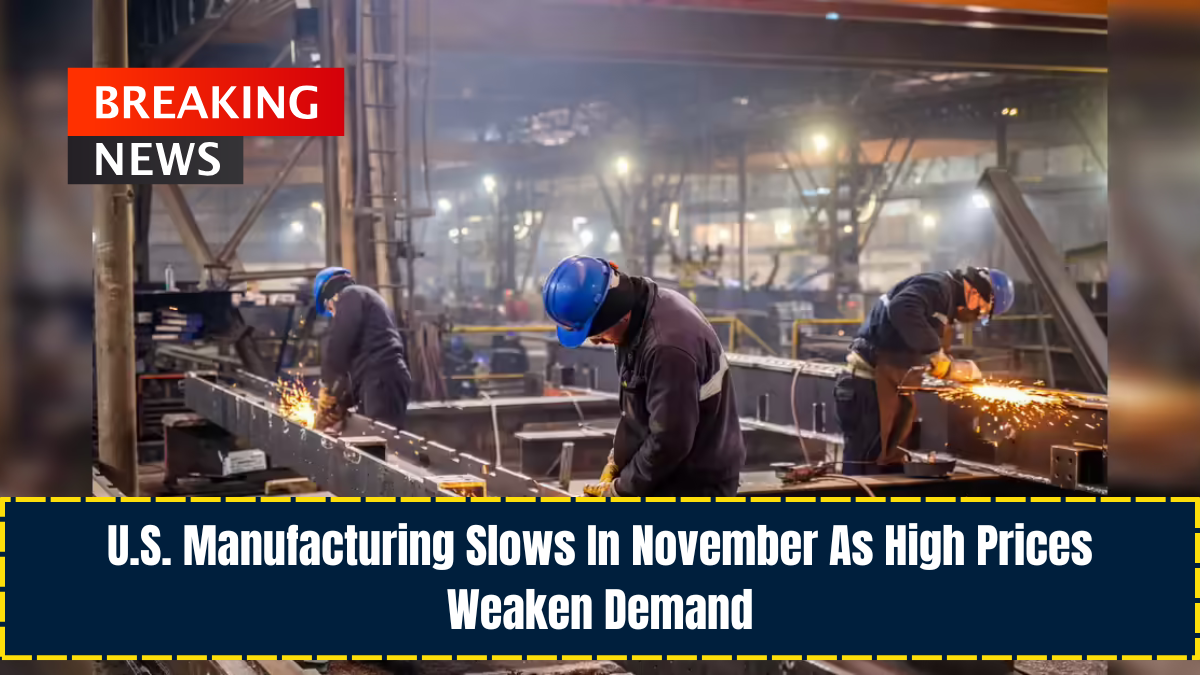The U.S. manufacturing sector cooled noticeably in November, slipping to its weakest level in four months.
Rising costs—largely driven by tariffs on imported goods—have discouraged consumer purchasing, leading to a growing stockpile of unsold products that may slow broader economic expansion.
Additional pressure came from the University of Michigan’s Surveys of Consumers, which revealed a sharp decline in buying conditions for long-lasting manufactured products.
The report noted that consumers remain frustrated by persistent inflation and weakening incomes.
Tariffs And Inflation Continue To Burden Households
Impact On Different Income Groups
President Donald Trump’s tariff-heavy trade policy has contributed to higher prices across many goods, squeezing budgets for middle- and lower-income families.
Wealthier households had been shielded somewhat due to strong stock market performance. However, the recent market downturn has damaged confidence among high-income earners and may curb their spending as well.
Economist Sung Won Sohn of Loyola Marymount University emphasized that lower-income consumers are unlikely to spend more under current conditions, while uncertainty in the stock market will also limit spending among affluent households, especially retirees.
Manufacturing PMI Declines While Inventories Reach Record High
Slowdown In New Orders
According to S&P Global, the flash U.S. Manufacturing PMI fell to 51.9, down from 52.5 in October.
Any reading above 50 signals growth, but the decline highlights weakening momentum in the sector, which makes up 10.2% of the U.S. economy.
Economists surveyed by Reuters had expected a milder dip to 52.0.
New factory orders dropped to 51.3 from 54.0, while inventories rose to the highest level ever recorded by the survey.
S&P economist Chris Williamson warned that this mix of slower demand and rapidly growing stockpiles suggests the possibility of slower factory production moving forward. If demand does not rebound, it may also negatively impact service industries.
Business Activity Holds Firm Despite Manufacturing Weakness
The slowdown has not yet spilled over into the broader economy. The U.S. Composite PMI Output Index—covering both manufacturing and services—edged up to 54.8, slightly higher than October’s reading of 54.6.
Services Sector Shows Stronger Performance
Demand Strengthens In Services
The services industry helped offset manufacturing weakness, with the sector’s PMI rising to 55.0 from 54.8. New orders also increased, climbing to 55.0 from 53.6.
S&P Global reported an increase in business confidence driven by several factors:
- Expectations of more interest rate cuts
- The end of a 43-day government shutdown
- Reduced political concerns
- Optimism for increased policy support
The survey was conducted between November 12 and November 20.
Improvement In Consumer Sentiment, But Pressures Remain
Consumer Confidence Data
Consumer sentiment showed a slight uptick as the University of Michigan’s Consumer Sentiment Index rose to 51, up from 50.3 earlier in November (the lowest reading in nearly 3.5 years). However, the index remains below its October level of 53.6.
Current assessments of personal finances and durable goods buying conditions both fell by more than 10%, but expectations for the future saw a minor improvement.
Survey director Joanne Hsu noted that sentiment among consumers with significant stock holdings dipped later in the month due to recent stock market declines.
Inflation Outlook And Rate Cut Expectations
Prices Continue To Rise
Inflation appears likely to stay elevated in the near term. The PMI survey showed:
- Prices received by businesses increased to 56.0, up from 54.7
- Input prices rose to 63.1, up from 60.0
Consumers also expect higher inflation over the next 12 months, though five-year inflation expectations fell slightly to 3.4% from 3.9%.
Despite the Federal Reserve’s rate cut in October, policymakers have expressed caution about any further reductions, given inflation remains above the 2% target.
Labor Market Still Stable
The S&P Global report showed no major labor market deterioration, even though the national unemployment rate hit a four-year high of 4.4% in September.
Private sector employment eased slightly from 51.3 to 51.0, with many firms citing tariff-related costs as a reason for hiring restraint.
The U.S. manufacturing sector is navigating a challenging environment marked by rising prices, declining new orders, and historic inventory growth.
While services continue to strengthen and business activity overall remains solid, ongoing inflation, higher consumer costs, and uncertain market conditions pose risks to future growth.
With both households and businesses feeling the effects of tariffs and economic uncertainty, the coming months will be crucial in determining whether demand can recover and prevent a deeper slowdown.




